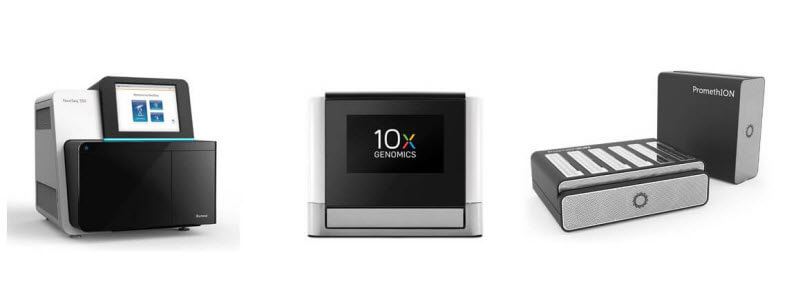 
Plateforme de génomique, IPMC UMR7275 660 Route des Lucioles, SOPHIA ANTIPOLIS, 06560 VALBONNE tél: 04-93-95-77-77, fax: 04-93-95-77-08 |
|
Expertise
La plateforme de génomique fonctionnelle de Nice Sophia Antipolis existe depuis 1999.
Initialement orientée vers la conception, la fabrication et l'analyse de puces à ADN, elle a contribué à ouvrir cette nouvelle technologie à
une large communauté, mettant à cette occasion en place un système d'information performant (Mediante),
capable de gérer de grandes masses de données, et fonctionnant en production depuis plus de 20 ans.
Equipements

Les résultats sont stockés automatiquement sur le portail d'informations de la plateforme Mediante. Cela concerne notamment les fichiers .BAM d'alignement, les fichiers .BW de couverture et l'ensemble des fichiers de l'analyse secondaire et des analyses statistiques conduites en partenariat avec le collaborateur. Sur demande l'ensemble des données brutes sont également mises à disposition et une aide est fournit pour la soumission des données vers la base de données publiques GEO (Gene Expression Omnibus). |
Related publicationsVirolle Virginie3 publications found1. Functional characterization of ATAD2 as a new cancer/testis factor and a predictor of poor prognosis in breast and lung cancers., Oncogene. 2010 Sep 16;29(37):5171-81. (Pubmed: 20581866)Caron C, Lestrat C, Marsal S, Escoffier E, Curtet S, Virolle V, Barbry P, Debernardi A, Brambilla C, Brambilla E, Rousseaux S, Khochbin S Cancer cells frequently express genes normally active in male germ cells. ATAD2 is one of them encoding a conserved factor harbouring an AAA type ATPase domain and a bromodomain. We show here that ATAD2 is highly expressed in testis as well as in many cancers of different origins and that its high expression is a strong predictor of rapid mortality in lung and breast cancers. These observations suggest that ATAD2 acts on upstream and basic cellular processes to enhance oncogenesis in a variety of unrelated cell types. Accordingly, our functional studies show that ATAD2 controls chromatin dynamics, genome transcriptional activities and apoptotic cell response. We could also highlight some of the important intrinsic properties of its two regulatory domains, including a functional cross-talk between the AAA ATPase domain and the bromodomain. Altogether, these data indicate that ATAD2 overexpression in somatic cells, by acting on basic properties of chromatin, may contribute to malignant transformation. 2. An open-access long oligonucleotide microarray resource for analysis of the human and mouse transcriptomes., Nucleic Acids Res. 2006 Jul 19;34(12):e87 (Pubmed: 17384016) Le Brigand K, Russell R, Moreilhon C, Rouillard JM, Jost B, Amiot F, Magnone V, Bole-Feysot C, Rostagno P, Virolle V, Defamie V, Dessen P, Williams G, Lyons P, Rios G, Mari B, Gulari E, Kastner P, Gidrol X, Freeman TC, Barbry P Two collections of oligonucleotides have been designed for preparing pangenomic human and mouse microarrays. A total of 148,993 and 121,703 oligonucleotides were designed against human and mouse transcripts. Quality scores were created in order to select 25,342 human and 24,109 mouse oligonucleotides. They correspond to: (i) a BLAST-specificity score; (ii) the number of expressed sequence tags matching each probe; (iii) the distance to the 3' end of the target mRNA. Scores were also used to compare in silico the two microarrays with commercial microarrays. The sets described here, called RNG/MRC collections, appear at least as specific and sensitive as those from the commercial platforms. The RNG/MRC collections have now been used by an Anglo-French consortium to distribute more than 3500 microarrays to the academic community. Ad hoc identification of tissue-specific transcripts and a approximately 80% correlation with hybridizations performed on Affymetrix GeneChiptrade mark suggest that the RNG/MRC microarrays perform well. This work provides a comprehensive open resource for investigators working on human and mouse transcriptomes, as well as a generic method to generate new microarray collections in other organisms. All information related to these probes, as well as additional information about commercial microarrays have been stored in a freely-accessible database called MEDIANTE. 3. Hypoxia-inducible factor 1{alpha} is a new target of microphthalmia-associated transcription factor (MITF) in melanoma cells., J Cell Biol. 2005 Jul 4;170(1):49-59. Epub 2005 Jun 27. (Pubmed: 15983061) Busca R, Berra E, Gaggioli C, Khaled M, Bille K, Marchetti B, Thyss R, Fitsialos G, Larribere L, Bertolotto C, Virolle T, Barbry P, Pouyssegur J, Ponzio G, Ballotti R In melanocytes and melanoma cells alpha-melanocyte stimulating hormone (alpha-MSH), via the cAMP pathway, elicits a large array of biological responses that control melanocyte differentiation and influence melanoma development or susceptibility. In this work, we show that cAMP transcriptionally activates Hif1a gene in a melanocyte cell-specific manner and increases the expression of a functional hypoxia-inducible factor 1alpha (HIF1alpha) protein resulting in a stimulation of Vegf expression. Interestingly, we report that the melanocyte-specific transcription factor, microphthalmia-associated transcription factor (MITF), binds to the Hif1a promoter and strongly stimulates its transcriptional activity. Further, MITF "silencing" abrogates the cAMP effect on Hif1a expression, and overexpression of MITF in human melanoma cells is sufficient to stimulate HIF1A mRNA. Our data demonstrate that Hif1a is a new MITF target gene and that MITF mediates the cAMP stimulation of Hif1a in melanocytes and melanoma cells. Importantly, we provide results demonstrating that HIF1 plays a pro-survival role in this cell system. We therefore conclude that the alpha-MSH/cAMP pathway, using MITF as a signal transducer and HIF1alpha as a target, might contribute to melanoma progression. |